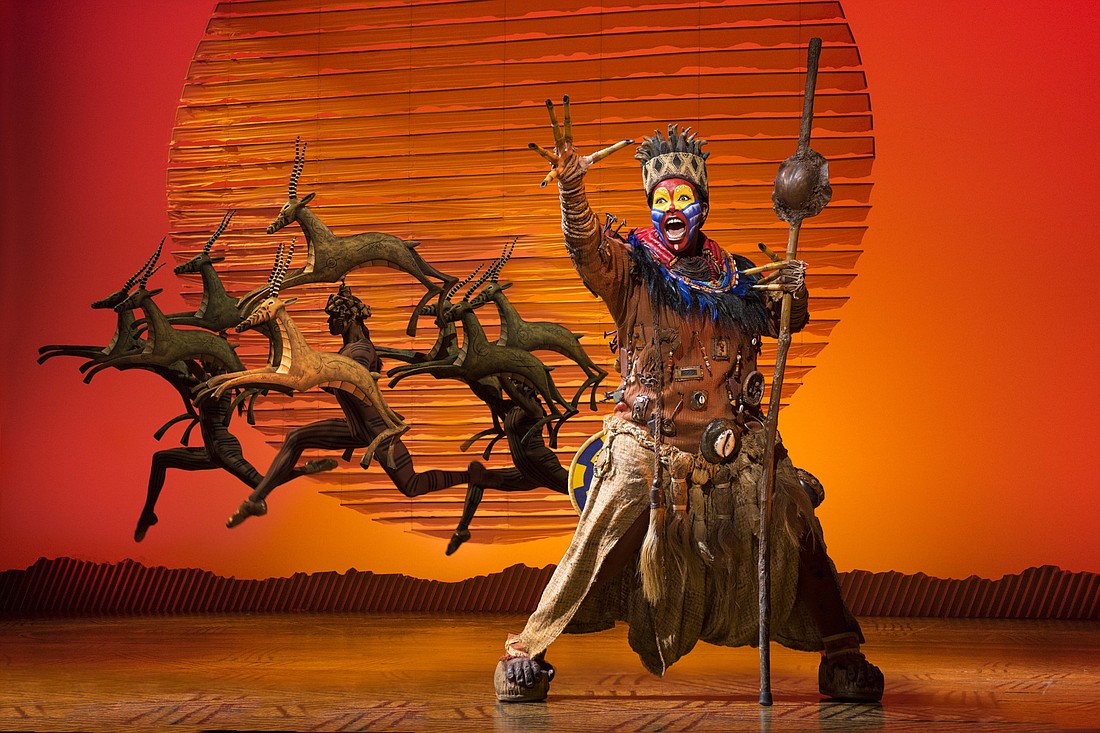- May 5, 2025
-
-
Loading

Loading

“The Lion King” just roared into town, and its den for the rest of the month is Van Wezel Performing Arts Hall. The musical won six Tony Awards, and it’s easy to see why. It’s many things, but above all it’s a show. In case you have any doubts, the opening scene dials the spectacle up to 11.
The musical opens on Pride Rock, a craggy mountaintop which serves as the royal throne of the Pride Lands in an idealized African savannah. Mufasa, (Gerald Ramsey) the Lion King, and Sarabi, (Chante Carmel) the Lion Queen, hold up Simba (Richard A. Phillips Jr.), their newborn lion cub. A procession of beasts greet the new arrival (brought amazingly to life by a team of puppeteers and actor/dancers), Whirling birds, giraffe-sized giraffes, elephantine elephants, and crouching lions form a majestic parade to the tune of “The Circle of Life.” The scene is a stunner, by design. The creators want you to go “wow.” Unless you’re comfortably numb, you will.
Now that you’re suitably awed, the story begins. The plot is doubtlessly familiar to anyone who was a kid, had a kid, or watched a kid in the last three decades. But here goes anyway …
Mufasa is the leonine ruler of the Pride Lands. Simba, his lion cub son, is next in line of succession. But Scar (Spencer Plachy), Mufasa’s Machiavellian brother, wants the throne for himself. He first tricks Simba into visiting the Elephant’s Graveyard, where the cub nearly becomes hyena food. Mufasa rescues him. But Scar’s next deception works. He lures Simba into a Wildebeest stampede. Mufasa rescues him again at the cost of his life. The stampede doesn’t kill him. But Scar does — and tricks Simba into thinking he’s responsible for his father’s death.
The cub flees and bumps into two party animals — Timon (Nick Cordileone), the meerkat, and Pumbaa (Ben Lipitz), the warthog. They teach Simba their laid-back, slacker motto: “Hakuna Matata.” (I think that’s Swahili for, “Party on, dude.” Back in the Pride Lands, Scar takes over, with the help of a pack of goose-stepping hyenas. While he’s good at seizing power, he doesn’t know what to do with it. The Pride Lands become a wasteland because of unchecked hunting under Scar’s rule. Simba searches his soul, and returns to do battle with Scar and set things right. (Spoiler alert, he does.) The circle of life is restored.
If it seems familiar, that’s because it is. “The Lion King” is “Hamlet” with a happy ending and lions. More than that, it follows the template of the hero’s journey in Joseph Campbell’s “The Hero with a Thousand Faces.” It’s an archetypal story — and that’s no put-down. Archetypes are archetypes for a reason. They hit us in the gut.
Ramsey’s Mufasa is suitably regal, without an ounce of pretension. He exudes authority without being a bully. Phillips Jr. delivers an athletic, energetic performance as the young Simba. He bounces around the stage like Tigger and seems to be having the time of his life. (He alternates with Walter Russell III in the role.) Jared Dixon is winning and vulnerable as the post-puberty Simba. Like Shakespeare’s Henry V, he has to leave his partying ways behind and embrace his royal destiny. Nia Holloway conveys a great strength as Nala, Simba’s once-and-future consort.
Like most great villains, Plachy’s Scar has a great vocabulary. His pretentious elocution (and affected British accent) is worthy of the Dr. Smith character on “Lost in Space.” He’s a very funny character. But, as Neil Gaiman observed, something funny can also be dangerous. Platchy’s portrayal is genuinely menacing. His hyena henchmen (Keith Bennett, Robbie Swift and Martina Sykes) supply their own mix of mirth and menace. Nick Cordileone and Ben Lipitz are also funny (without a speck of menace) as Simba’s goofy, vaudevillian comic sidekicks. Buyi Zama’s Rafiki is a shamanic mandrill. She alternates between cascades of prophecy in Zulu and pithy statements in English. (There’s a delightful Zen moment where she whacks Simba on the head with her staff.) Greg Jackson is equally funny as Zazu, Mufasa’s consigliore. He’s proof that a good vocabulary isn’t always a sign of a wicked heart.
It’s a brilliant show — and there’s clearly an army of creative talent involved. Roger Allers and Irene Mecchi wrote the book. They stuck close to the witty dialogue of the animated feature, but expanded the core story, and threw in a few timely references for good measure. Along with directing the show, Julie Taymor collaborated with the writers, and also worked with Michael Curry on the masks and articulated puppet designs.
The songs (“Circle of Life,” “Hakuna Matata,” “Be Prepared,” etc.) are some of Tim Rice and Elton John’s best work. They’re beefed up by additional tunes (by Mark Mancina, Lebo M (the celebrated South African composer), Jay Rifkin, Hans Zimmer and the multitalented Taymor) in the spirit of traditional African music.
These top-flight talents color outside the lines of their creative specialties. Richard Hudson gets credit for the amazing set; Donald Holder supplies the evocative lighting; and Garth Fagan jump-started the energetic choreography. But it’s hard to tell where one artist stops and another starts. Choreography bleeds into mime, which bleeds into various forms of puppetry, which bleeds into costume design. (Many actors wear their articulated puppet costumes, with animal masks above their faces.) The sets move and become part of the dance. It all adds up to one seamless vision. Where the lines just don’t matter.
“The Lion King” offers a sweet, pop transcendentalism. It also weaves an ecological subtext into the drama without hitting you over the head. It’s a life-affirming message and an evening of pure entertainment. What was born as a cartoon cub has grown into a roaring lion on stage.
Hakuna matata, y’all.
To learn about a former Westcoast Black Theatre Troupe performer who landed an ensemble role in the show, click here.